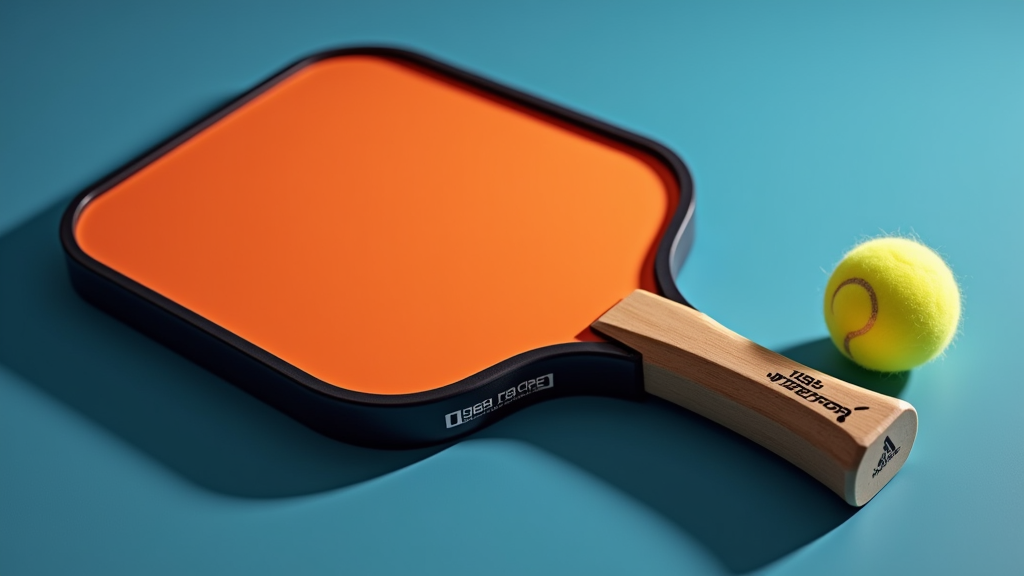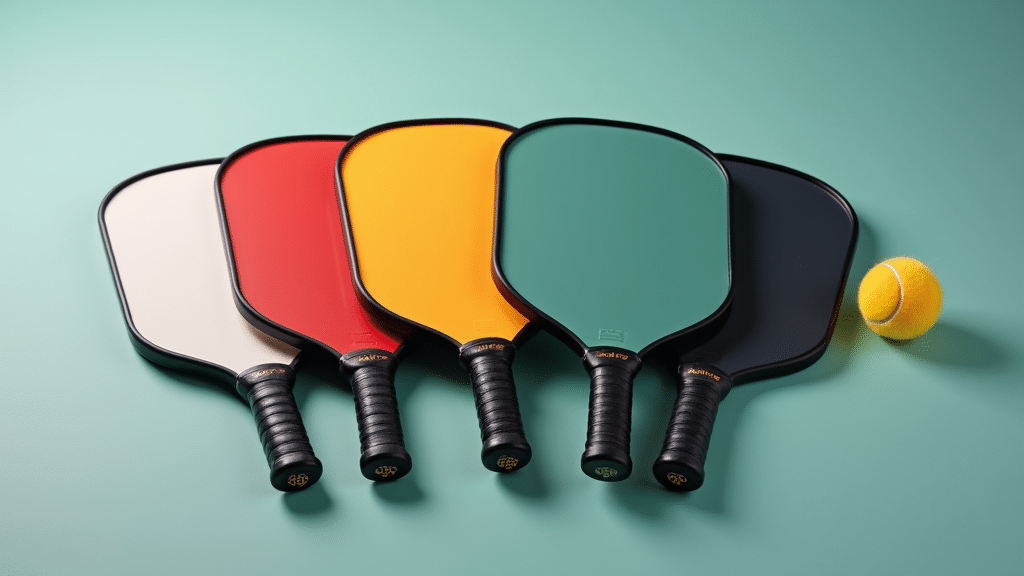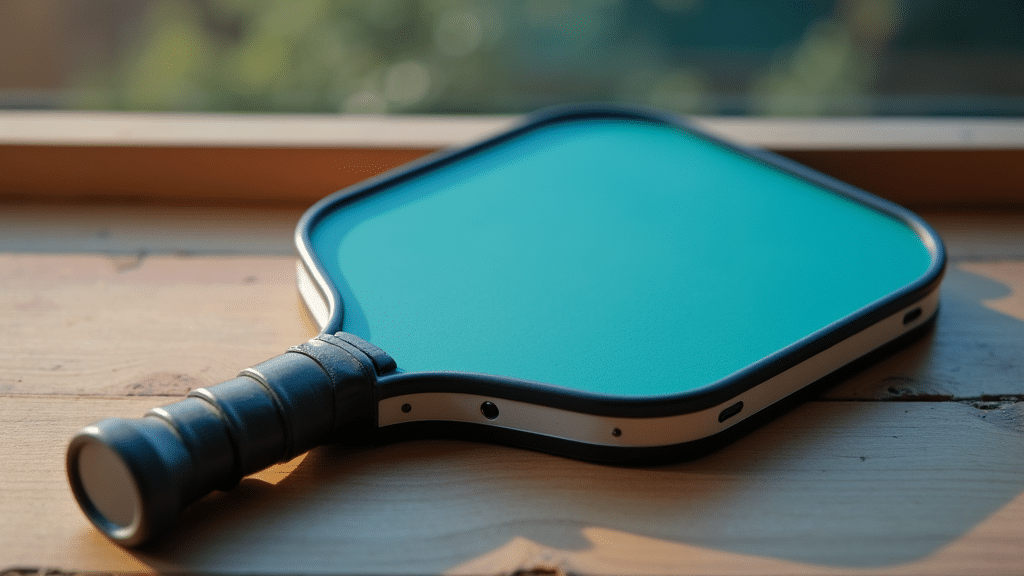Table of Contents
- Introduction
- Understanding the Basics
- Detailed Guide
- Paddle Weight Categories
- Modifying Paddle Weight: Practical Application
- Important Considerations
- Conclusion
Introduction
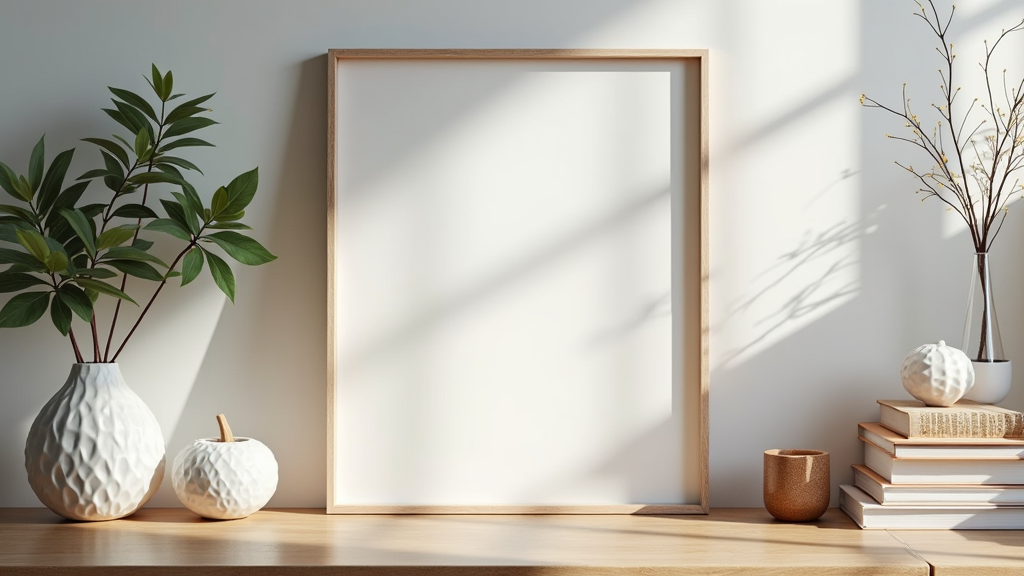
Overview and Importance
The weight of your pickleball paddle is a critical factor that significantly impacts your performance on the court. It’s not just about how heavy the paddle feels in your hand; it’s about how that weight translates into speed, control, power, and even your risk of injury. A paddle that’s too heavy can slow down your reaction time and lead to fatigue, while one that’s too light might lack the power you need for aggressive shots. Interestingly, a recent study revealed that 53.2% of pickleball players do not add any weight to their paddles, suggesting a potential gap in understanding the benefits of customization.
Background
The average pickleball paddle weighs around 8 ounces (227 grams), a sweet spot designed to balance maneuverability and power. Compared to tennis rackets, which typically weigh between 10.6 and 11 ounces, and racquetball rackets, which tend to be lighter, pickleball paddles occupy a unique middle ground. However, the beauty of pickleball lies in its adaptability. Players have various options to modify their paddle weight, primarily through the use of lead tape, which adds weight to specific areas of the paddle, and overgrips, which can subtly increase the handle size and overall weight.
What You’ll Learn
In this blog post, we’ll delve into the fascinating world of pickleball paddle weight and its profound effect on your game. You’ll gain a comprehensive understanding of how paddle weight influences your shots, your stamina, and your overall playing experience. We’ll guide you through the process of choosing the right paddle weight based on your individual playing style, strengths, and weaknesses. Finally, we’ll explore various methods for adjusting paddle weight, providing insights into how each adjustment can fine-tune your paddle’s performance to perfectly match your needs.
Understanding the Basics
Fundamental Concepts
Before diving into customizing your pickleball paddle, it’s crucial to understand some fundamental concepts that dictate how a paddle performs. These elements influence power, control, and overall feel, and adjusting them can significantly impact your game.
- Weight:This refers to the mass of the paddle, typically measured in ounces or grams. A heavier paddle generally provides more power, while a lighter paddle allows for quicker reactions and maneuverability.
- Balance:Balance describes how the weight is distributed across the paddle. It can be head-heavy, meaning more weight is concentrated in the paddle’s head; handle-heavy, with more weight in the handle; or balanced, with the weight evenly distributed. The balance point affects how the paddle feels during swings and impacts its overall agility.
- Swing Weight:Swing weight is a measure of how heavy the paddlefeelswhen you swing it. It’s not just about the static weight of the paddle, but also how the weight is distributed. A higher swing weight makes the paddle feel heavier and can generate more power, while a lower swing weight makes it feel lighter and easier to swing quickly.
- Sweet Spot:The sweet spot is the area on the paddle face that provides the most consistent and powerful response when you hit the ball. A larger sweet spot offers more forgiveness on off-center hits, while a smaller sweet spot requires more precision but can offer more control.
Essential Components
Now that we’ve covered the basic concepts, let’s break down the essential components of paddle weight and distribution, and explore the materials you can use to fine-tune them.
- Paddle Weight:
- Weight Distribution:
- Materials for Adding Weight:
- Lightweight:Typically 7.2 oz (204 grams) and below. Lightweight paddles are favored by players who prioritize speed, quick reactions at the net, and reduced strain on the arm.
- Midweight:Ranging from 7.3 – 8.4 oz (207-238 grams), midweight paddles offer a balance of power and control, making them a popular choice for a wide range of players.
- Heavyweight:At 8.5 oz (241 grams) and more, heavyweight paddles provide maximum power and stability, ideal for players who like to drive the ball deep and control the pace of the game.
- Head-heavy:More weight towards the paddle head increases power and stability, particularly on groundstrokes. However, it can reduce maneuverability at the net.
- Handle-heavy:More weight towards the handle enhances maneuverability and control, making it easier to react quickly and generate spin. It may sacrifice some power.
- Balanced:Evenly distributed weight provides a good compromise between power and control, allowing for a versatile playing style.
- Lead Tape:A common choice for adding weight, lead tape typically adds approximately 1.8-2 grams per inch. It’s easily applied to the paddle’s edge or handle to adjust the balance and swing weight.
- Tungsten Tape:A denser alternative to lead tape, tungsten tape adds approximately 1 gram per inch but occupies less space. This makes it ideal for fine-tuning weight without significantly altering the paddle’s profile.
- Electrical Tape:While not as dense as lead or tungsten tape, electrical tape can be used for minor weight adjustments, adding approximately 1 gram per inch. It’s also useful for protecting the paddle’s edge.
- Grips/Overgrips:Replacing or adding grips and overgrips can subtly alter the paddle’s weight and balance. The weight added varies depending on the specific grip. Experiment with different grips to find one that enhances your feel and control.
Detailed Guide

Preparation
Before you even think about slapping on some lead tape, a little prep work goes a long way. First, grab a scale and <strong>determine your current paddle weight</strong>. This gives you a crucial baseline for measuring your adjustments. Knowing where you started is key to understanding the impact of each change you make.
Next, <strong>identify your goals</strong>. What are you hoping to achieve by adding weight? Are you craving more power behind your drives? Do you need more control for delicate dinks? Or perhaps you’re looking for faster hand speed at the net. Pinpointing your objectives will guide your weight placement strategy. For example, if you want more power, you might focus on the top of the paddle. If you want more control, you might focus on the sides.
Finally, <strong>gather your materials</strong>. You’ll need lead tape or tungsten tape (tungsten is denser, so you can use less), electrical tape to secure the lead tape, an overgrip to cover the added weight under the handle if desired, and, of course, that trusty scale to keep track of your progress. Having everything ready ensures a smooth and efficient customization process.
Step-by-Step Process
Now for the fun part! Remember, the key here is to <strong>start small</strong>. Resist the urge to slap on a ton of weight right away. Instead, add weight in small increments, like 2-4 grams at a time. This allows you to feel the subtle changes and avoid overdoing it.
<strong>Placement</strong> is everything. Experiment with different locations on the paddle to see how they affect performance:
- Sides:Adding weight to the sides of the paddle generally increases stability and expands the sweet spot, making off-center hits more forgiving.
- Neck Area:Weight in the neck area can also add stability and some players report it adds a little “pop” to their shots.
- Top Edge:This is the classic power placement. Adding weight to the top edge increases the paddle’s swing weight, leading to more powerful shots. However, be aware that it can also slow down your hand speed.
- Four Corners:Distributing weight evenly in the four corners of the paddle adds balanced weight, which can improve both the sweet spot and power without drastically altering the paddle’s feel.
- Under/Over Grip:Adding weight under the overgrip, or replacing the grip with a heavier one, can help balance a head-heavy paddle, making it feel more maneuverable.
After each adjustment, it’s crucial to <strong>test and evaluate</strong>. Head to the court and play with your modified paddle. Pay attention to how it feels in your hand, how the ball comes off the face, and how your shots are performing. Does it feel more stable? Are you getting more power? Are you sacrificing control? Be honest with yourself about the changes you’re experiencing.
Finally, <strong>adjust as needed</strong>. This is an iterative process. Based on your testing, fine-tune the weight and placement until you achieve your desired results. Don’t be afraid to experiment and make changes until you find the sweet spot for your game.
Advanced Techniques
Once you’ve mastered the basics, you can delve into more advanced techniques. <strong>Swing weight adjustment</strong> becomes paramount. This refers to how the paddle *feels* when you swing it, not just the static weight you see on the scale. Two paddles can weigh the same but have drastically different swing weights due to weight distribution.
<strong>Customization</strong> is key to making the paddle truly your own. Tailor the weight distribution to perfectly match your specific playing style. Do you prefer aggressive baseline play? Or are you a finesse player at the net? Adjust the weight to enhance your strengths and compensate for your weaknesses.
If you’re feeling lost or unsure, consider seeking a <strong>professional consultation</strong>. A qualified pickleball coach or equipment specialist can provide valuable insights and guidance based on your individual needs and playing style. They can analyze your swing, assess your paddle, and recommend specific weight adjustments to optimize your performance.
Finally, be aware of potential <strong>troubleshooting</strong> issues:
- Too much weight:Adding too much weight can reduce your hand speed, increase fatigue, and even increase your risk of injury. If you start feeling sluggish or your arm starts to ache, it’s a sign you’ve gone too far.
- Too little weight:On the other hand, adding too little weight may result in a lack of power and an unstable feel. If you’re not noticing any significant improvement, you may need to add a bit more weight.
Paddle Weight Categories
Paddle weight is a crucial factor that significantly impacts your game. It influences everything from swing speed and power to control and comfort. Choosing the right weight can enhance your strengths and compensate for weaknesses, while the wrong weight can lead to fatigue, injury, and a frustrating playing experience. Pickleball paddles are generally categorized into three weight classes: lightweight, midweight, and heavyweight. Let’s delve into each category to understand their unique characteristics and suitability for different players.
Lightweight Paddles (7.2 oz / 204 grams and Below)
Lightweight paddles are designed for speed and maneuverability. Weighing in at 7.2 oz (204 grams) or less, these paddles are a popular choice for players who prioritize quick reactions and finesse.
- Advantages:
- Fast, efficient swings: The light weight allows for quicker swing speeds, enabling faster reactions at the net and more efficient shot placement.
- Ideal for quick movements and controlled shots: Lightweight paddles excel in situations demanding rapid responses and precise ball placement.
- Reduced arm and wrist strain: The lighter load minimizes stress on the arm and wrist, making it a comfortable option for extended play.
- Disadvantages:
- Creates more vibration: Due to their lighter mass, these paddles tend to transmit more vibration upon impact, which some players find uncomfortable.
- Not suitable for players prone to tennis elbow: The increased vibration can exacerbate tennis elbow symptoms.
- Difficult to use in windy conditions: Their light weight makes them more susceptible to wind interference, affecting shot accuracy.
- Ideal For:
- Beginners: The ease of handling and reduced strain make them a great starting point for new players.
- Players transitioning from table tennis: The emphasis on control and quick reactions aligns well with the skills honed in table tennis.
- Players who prioritize control and quick reactions: Those who value precision and fast reflexes will find these paddles highly beneficial.
Midweight Paddles (7.3 – 8.4 oz / 207-238 grams)
Midweight paddles strike a balance between power and control, making them a versatile option for a wide range of players. Typically weighing between 7.3 and 8.4 oz (207-238 grams), these paddles offer a blend of maneuverability and stability.
- Advantages:
- Balances power and control: Midweight paddles provide a harmonious combination of power for offensive shots and control for delicate maneuvers.
- Less power needed for blocking: The added weight assists in blocking powerful shots with less effort.
- Suitable in windy conditions and doubles play: Their moderate weight offers better stability in windy environments and enhances performance in doubles matches.
- Easier on wrist mechanics due to moderate weight: The balanced weight distribution reduces strain on the wrist, promoting comfortable play.
- Absorbs impact vibration, providing smooth shots: The added mass helps dampen vibrations, resulting in smoother and more comfortable shots.
- Disadvantages:
- Can be challenging during continuous power plays: While balanced, they may require more effort during extended periods of aggressive play.
- Less controllable than lightweight paddles: The increased weight slightly reduces maneuverability compared to lightweight options.
- Slightly less powerful than heavyweight paddles: They don’t offer the same raw power as their heavier counterparts.
- Ideal For:
- Former/current tennis players: The blend of power and control aligns well with the skills developed in tennis.
- Players with tennis elbow: The vibration dampening properties can help alleviate discomfort.
- Players seeking a balance of power and control: Those who desire a versatile paddle for all-around performance will find midweight paddles ideal.
- Intermediate to advanced players who play frequently: The balanced characteristics make them suitable for regular play at higher skill levels.
Heavyweight Paddles (8.5 oz / 241 grams and More)
Heavyweight paddles are built for power and stability. Weighing 8.5 oz (241 grams) or more, these paddles are favored by players who prioritize forceful shots and solid blocking.
- Advantages:
- Generates more power: The added weight translates to increased momentum, resulting in more powerful shots.
- Provides stability: Heavyweight paddles offer enhanced stability, particularly during fast-paced exchanges.
- Suitable in windy conditions: Their substantial weight provides excellent resistance to wind interference.
- Increased power and depth in shots: The added mass allows for deeper and more forceful shots, pushing opponents back.
- Effective for blocking hard volleys: The weight provides a solid barrier for deflecting powerful incoming shots.
- Disadvantages:
- Challenging for beginners: The heavier weight can be difficult to control for new players.
- Can cause arm fatigue: The added strain can lead to fatigue, especially during long matches.
- Reduced flexibility and quick reactions: The heavier weight can slow down swing speed and reaction time.
- More likely to cause arm fatigue over time: The increased strain can contribute to long-term arm fatigue and potential injuries.
- Ideal For:
- Slower, more experienced players: Those with a more deliberate playing style and established technique can harness the power effectively.
- Former tennis players: The emphasis on power and stability aligns well with tennis-based techniques.
- Players prioritizing power and a robust playing style: Those who want to dominate with forceful shots will appreciate heavyweight paddles.
- Those without joint issues, and in singles play: Players with strong joints and a preference for singles matches, where power is paramount, will find these paddles advantageous.
Modifying Paddle Weight: Practical Application
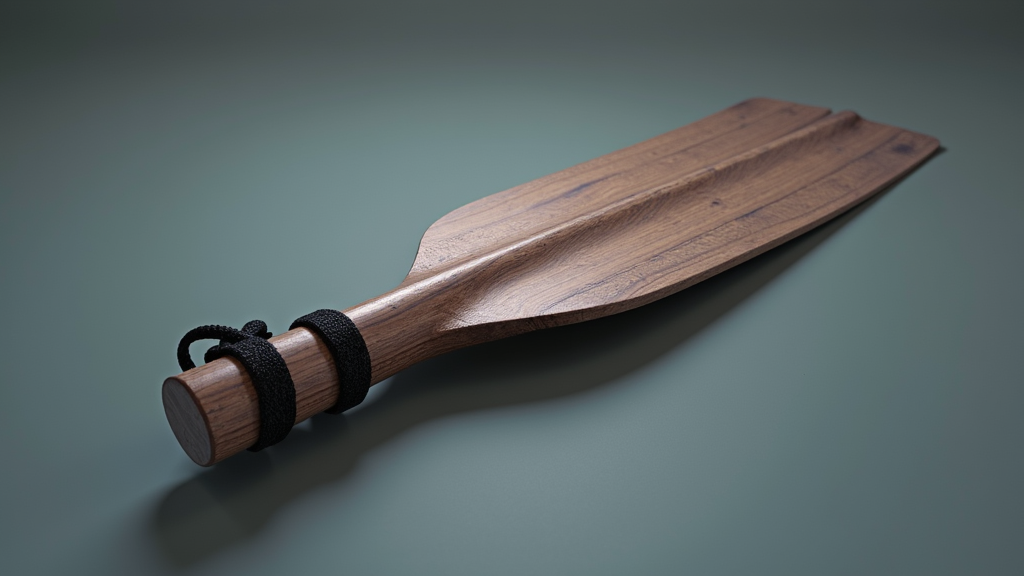
Weight Tape Options
When it comes to modifying your paddle’s weight, you have several tape options available, each with its unique characteristics. The choice often boils down to personal preference, budget, and desired outcome.
- Lead Tape:This is a popular choice among players due to its high density, typically adding about 1.8 to 2 grams per inch. Lead tape allows you to add a significant amount of weight in a small area. However, be aware of lead’s toxicity and handle it with care.
- Tungsten Tape:If you’re looking for a non-toxic alternative to lead tape, tungsten tape is an excellent option. While slightly less dense than lead, it still provides a good amount of weight, approximately 1 gram per inch. It’s safe to handle and environmentally friendly.
- Electrical Tape:For a low-cost and readily available option, electrical tape can be used to add weight to your paddle. Keep in mind that it’s less dense than lead or tungsten, adding around 1 gram per inch. It’s a good option for making minor adjustments or experimenting with weight placement.
- Weight Strips:If you’re new to modifying paddle weight, consider starting with pre-cut weight strips, typically around 3 grams each. These strips make it easier to add weight incrementally. Packs usually contain 12 strips, giving you plenty of room to experiment and fine-tune your paddle’s balance.
Placement Strategies
Where you place the added weight on your paddle can significantly impact its performance. Experiment with different locations to find what works best for your playing style.
- Paddle Head:Adding weight to the paddle head increases its swing weight, resulting in more power behind your shots. This can be beneficial for drives and overheads. However, it can also make the paddle feel less maneuverable and potentially increase the risk of arm or shoulder injuries if you’re not used to the added weight.
- Center/Sides:Placing weight along the center or sides of the paddle enhances stability and expands the sweet spot. This makes the paddle more forgiving on off-center hits, leading to more consistent shots. This placement is ideal for players looking for more control and stability.
- Paddle Neck:Adding weight to the paddle neck can improve stability, especially for players who tend to miss shots on the lower half of the paddle face. This placement helps to stabilize the paddle during contact and can improve accuracy on low volleys.
- Corners:Placing weight in the corners of the paddle can boost both power and stability. This option is a good choice for players who want a balance of both, but it can slightly reduce hand speed, making it harder to react quickly at the kitchen line.
- Over/Under Grip:Adding weight under or over the grip tape makes the grip thicker and adds maneuverability at the kitchen line. This can be helpful for quick reactions and dinking.
Implementation Advice
Modifying your paddle’s weight should be a gradual and thoughtful process. Here are some essential tips to keep in mind:
- Start Minimal:Always begin by adding a minimal amount of weight. It’s easier to add more weight than to remove it. Small changes can make a big difference in how the paddle feels and performs.
- Evaluate First:Before making any modifications, carefully evaluate your paddle use and identify any areas where you’re consistently making errors. Are you lacking power? Are you struggling with stability? Understanding your weaknesses will help you determine the best placement for the added weight.
- Test Periodically:After each modification, take the time to test the paddle thoroughly during practice or casual play. Pay attention to how the paddle feels and how it affects your shots. Make sure you are adapting well to the changes and that the added weight is improving your game.
- Listen to Your Body:If you experience any pain or discomfort after adding weight to your paddle, remove it immediately. Playing with a paddle that’s too heavy or unbalanced can lead to injuries. Prioritize your health and well-being over any perceived performance gains.
Important Considerations
Legality
One of the first questions players often have about using lead tape is whether it’s even allowed. The good news is that according to USAP (USA Pickleball Association) guidelines, the use of paddle weight tape, including lead tape, is perfectly legal. This means you can experiment with customizing your paddle without fear of violating any official regulations, as long as you adhere to overall paddle weight and size restrictions.
Usage Across Skill Levels
While adding lead tape can potentially benefit players of all skill levels, its effectiveness is often maximized when applied with a solid understanding of the game. Beginners might find some benefit in terms of stability, but the nuances of weight distribution and its impact on shot control are generally better appreciated and utilized by intermediate to advanced players. These more experienced players can strategically place the tape to fine-tune their paddle’s performance based on their specific playing style and needs.
Potential Performance Benefits
The strategic application of lead tape can unlock several performance enhancements. One of the most sought-after benefits is the ability to add extra power to your shots. By increasing the overall weight of the paddle, you generate more momentum during your swing, resulting in a more forceful impact on the ball. Furthermore, the added weight can contribute to improved shot forgiveness. A heavier paddle tends to be more stable, reducing the effects of off-center hits and helping you maintain control even when you don’t strike the ball perfectly. Finally, lead tape can be used to subtly alter the size and location of the paddle’s sweet spot, allowing you to optimize it for your preferred hitting zone.
Risk of Injury
It’s crucial to acknowledge that modifying your paddle’s weight can also introduce a risk of injury if not approached with caution. The added weight, while beneficial for power and stability, can place increased strain on your arm and wrist muscles over time. This is especially true if you significantly increase the paddle’s weight or if you have pre-existing conditions. It’s essential to pay close attention to your body and monitor for any unusual aches or discomfort. If you experience any persistent pain, it’s advisable to consult with a doctor or physical therapist to prevent potential overuse injuries.
Conclusion

Summary of Key Points
Throughout this guide, we’ve emphasized the crucial role paddle weight plays in your pickleball performance. Understanding how weight affects your game is the first step toward making informed equipment choices. Remember that paddle weight significantly impacts everything from your swing speed and control to your stamina and risk of injury. A heavier paddle can provide more power, but it may also slow down your reaction time and increase the strain on your joints.
Choosing a paddle weight that matches your playing style and physical capabilities is essential. Aggressive players who prioritize power might prefer a heavier paddle, while those who value finesse and quick reactions may opt for a lighter one. However, your physical strength and endurance should also be considered to prevent fatigue and potential injuries.
Experimenting with weight adjustments is a valuable strategy for optimizing your paddle. Many players find that adding weight to specific areas of the paddle can fine-tune its balance and improve their performance. This allows for personalized customization to match individual preferences and playing styles.
Ultimately, prioritizing comfort and safety is paramount. An improperly weighted paddle can lead to discomfort, fatigue, and even injuries like tennis elbow. Always listen to your body and adjust your paddle weight as needed to ensure a comfortable and safe playing experience.
Final Recommendations
If you’re unsure where to start, we recommend choosing a midweight paddle. This provides a balanced combination of power and control, allowing you to develop your skills and identify your preferred playing style. From there, you can experiment with lighter or heavier paddles to find the perfect fit.
Monitor your paddle performance and focus on comfort rather than solely on power and speed. While a heavier paddle may initially seem to add power, it can also lead to fatigue and decreased control over time. Pay attention to how your body feels and adjust your paddle weight accordingly.
When making weight adjustments, we suggest doing so in gradual increments. Adding too much weight at once can drastically change the paddle’s feel and potentially lead to injury. Small, incremental changes allow you to fine-tune the weight and balance to your liking without overwhelming your muscles and joints.

